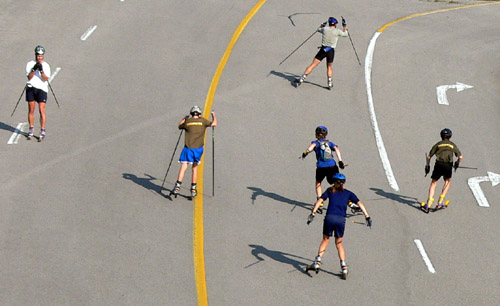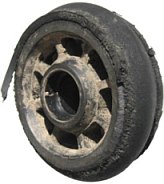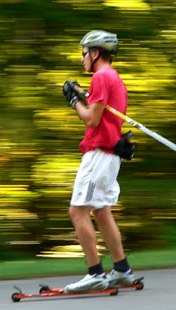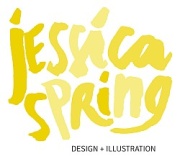Hi gang. I would be interested in hearing your opinions on roller skis for novices. While I have been on XC skis on and off for 12 years or so, I have never roller skied. I would certainly like to spend some time on them this year. Originally I thought I could just buy any pair with speed reducers (either skate or combi versions), but after preliminary research, there is much more to the story than I previously thought. Anyway, if anyone has any thoughts on this subject I would love to hear them...thanks!
Also, is there anyone on the list that roller skis in the Toronto area? I suspect that the park system would suffice...along with the Goodman Trail...eventually I would like to add some residential travel in order to get to the gym...thoughts here also appreciated!
B.W.

Good question. The XC Ottawa racing team has spent a few years on rollerskis, so we thought we might have a go at an answer. We've listed below a compendium of rollerski links and resources that we thought people might find useful (and entertaining, in some cases).
Yes, there is a lot more to rollerskis than first appears. Major factors to consider when purchasing are:
- Skate or classic or combi.
- Wheel speed.
- Stability.
- Replacement wheels and costs.
Skate, classic or combi . . .
Several manufacturers make decent combi skis, but in general, we would recommend getting classic or skate skis. The reasons are that classic and skate rollerskis are different enough that the compromise in making a combi results in a product not optimally suited for either technique. Length (skate skis can be shorter), wheel thickness (skate skis have much narrower wheels), balance point for binding placement (slightly further back for classic) all make for important differences. As well, the way you wear your wheel down as you use it for skating will degrade your ability to ski classic on the skis.
Wheel speed . . .
You need to suit your wheel choice to where you will be rollerskiing. A very few people like to rollerski on fine gravel roads or smooth dirt trails, in which case you could use Elpex's off-road rollerskis (inflatable wheels). Most people, however buy conventional rollerskis with solid synthetic/rubber wheels. Of those, you need to think hard about terrain. Smooth, usually dry pavement? (synthetic is ok and will last a lot longer). Wet or rough pavement? (rubber will grab better on wet and handle rough pavement better, but wear 2-3x more quickly.) Lots of hills, maybe with traffic stops on them? (BUY SLOW WHEELS!! Rubber is usually slower, but the easiest way to regulate is with bearing speed. Most companies have several different bearing speeds. Speed reducers are ok, but not a substitute for slow wheels) Racing? (Buy FAST wheels, synthetic and dense compounds).
Stability . . .
This is very important for all rollerskiers, especially for novices. You are higher off the ground than with a ski, and two wheels at either end rather than a flat ski under you make for a less stable surface. Plus, if you fall, you're falling on pavement. Classic rollerskis are usually more stable than skate skis, but the ratchet motion on a classic ski can be tricky for novice skiers. Plus, the lack of ankle support results in less stability for rollerskiing than for skiing - be careful. To maximize stability and control, you could try short skis, but you will sacrifice some smoothness. Look for a ski where the binding is low to the ground, where the wheels are solid, etc.
Replacement wheels and costs . . .

Rollerski wheels will wear out, it's a fact. Depending on how much use they get and the road surface that you are using them on, the wheels can wear quite fast. It's not uncommon to replace all four skating wheels every year. Classic wheels wear a lot less, but also need replacing occasionally. Before you buy rollerskis, ask about the availability and costs of replacement wheels. Until recently replacing wheels was almost the equivalent of buying new rollerskis, but cheaper alternatives exist and you should make sure that they are available for the brand of ski you buy.
Many companies make decent rollerskis, and prices have dropped in recent years. Good rollerskis are made by Elpex, V2, Ski Skett, and Marwe, and many are available locally (e.g., Fresh Air Experience) or by mail order.
There are some general things to consider (words of warning before you spend $200-$500 on some skis).
BE SAFE!

Rollerskiing is not a safe activity. Rollerskis do not have brakes (with some very rare exceptions), and, unless you're lucky, you will be rollerskiing on public access, uncontrolled paths or roads. Be careful where you ski, always know the downhills, and ALWAYS ALWAYS wear a helmet. You might want to consider speed reducers that allow you to adjust the speed of your skis, which is helpful for some downhills.
If you are a novice/intermediate skier who is looking to improve your technique in the summer, rollerskiing might not be the best method: this could be debated, but if you do not have solid technique fundamentals prior to rollerskiing, it is easy to pick up some bad technique habits. You would be far better served by some dry-land technique drills, or by taking a few lessons on skis in the winter.
Also beware of potential overuse injuries resulting from many repetitions of the same motion without a break. In addition or instead of rollerskiing, consider other summer activities (trail running, cycling, paddling, soccer, etc) that provide different motions, and also strengthen muscle groups that will provide complementary benefits during the winter skiing months.
Hope that helps!
Photos by Jo-Ann Holden.


